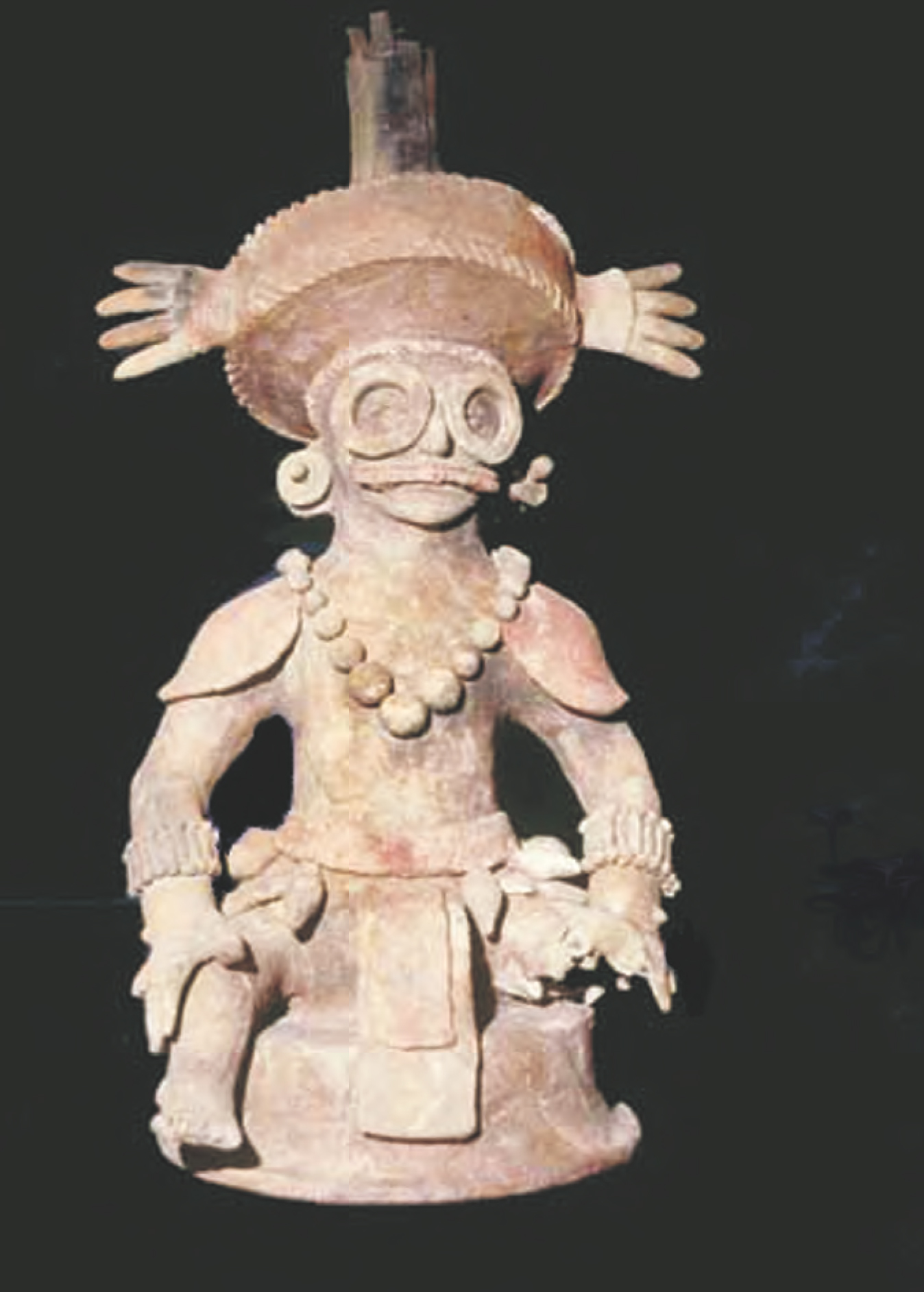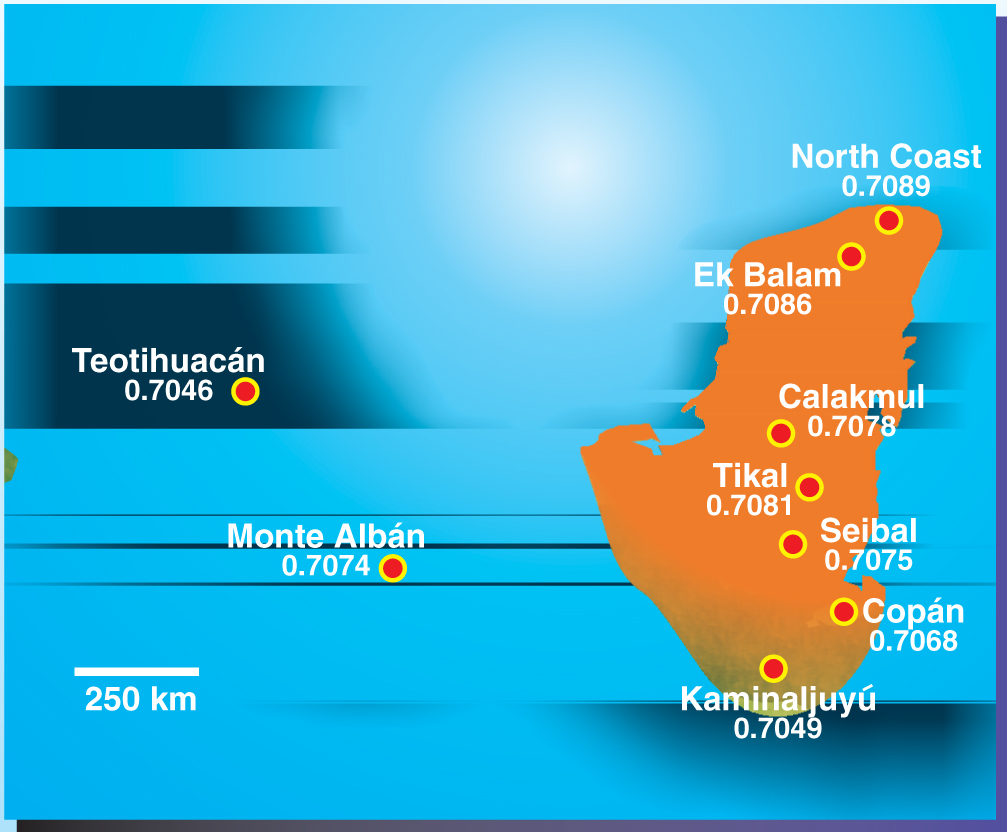Isotopic Analysis of Teeth and Bones Solves a Mesoamerican Mystery
DOI: 10.1063/1.1650060
At the start of the fifth century AD, Copán was a modest village set in a fertile, mountainous valley on the eastern fringe of the Maya world. Within decades, the village embarked on a remarkable rise to become, at its zenith in the eighth century, among the most accomplished Maya cities in art, architecture, and astronomy.
The transfiguration’s instigator was a man named Yax K’uk Mo. According to glyphs carved on a stone altar, Yax K’uk Mo arrived at Copán on 8 February 427, five months after his coronation on 5 September 426. The dynasty he founded ruled Copán for the next four centuries.
Despite their calendrical exactitude, the terse carvings are vague about Yax K’uk Mo’s origin or where and by whom he was crowned. Like ancient Greece or Renaissance Italy, the Maya world consisted of independent city-states linked by trade and vying for hegemony. Conceivably, any one of the rival cities could have been Yax K’uk Mo’s hometown and source of power.
But there’s another possibility. Beyond the Maya world, in the valley of Mexico, lay Teotihuacán, the largest city in pre-Columbian Mesoamerica. At its height, Teotihuacán spread over 20 square kilometers and accommodated upward of 200 000 people. Its influence pervaded the region. Cities hundreds of miles away copied its style of temples and adopted its fashions and gods. If Teotihuacán exerted influence through military might, Yax K’uk Mo could, quite plausibly, have been one of its provincial warlords.
Copánec artisans certainly depicted Yax K’uk Mo with Teotihuacáno trappings. Figure 1 shows the king wearing goggles that form part of a characteristically Teotihuacáno war helmet. And in his tomb, which was discovered in 1995, archaeologists found pottery from Teotihuacán.

This ceramic figurine of Yax K’uk Mo shows the king wearing goggles characteristic of Teotihuacán. The figurine, which is about 70 cm tall, dates from 695 AD, 269 years after Yax K’uk Mo’s coronation.

But the tomb also contained pottery from Tikal, a Maya city north of Copán, as well as pottery from Copán itself. As for the goggles, it’s understandable that a local magnate would want, if only through symbols, to draw authority and legitimacy from the region’s preeminent power.
The question of Yax K’uk Mo’s provenance is now much clearer. By analyzing isotope ratios in Yax K’uk Mo’s teeth and bones, a team led by Jane Buikstra of the University of New Mexico has ruled out Teotihuacán as Yax K’uk Mo’s place of birth and early childhood. 1 Instead, it appears the king grew up in central Yucatán, the heart of the Maya world.
Strontium and oxygen
Isotope-based sourcing relies not only on nuclear physics, but also on Earth science and biology. Strontium, which sits just below calcium in group II of the periodic table, has four naturally occurring isotopes. One of them, strontium-87, is the decay product of rubidium-87. The other three, 84Sr, 86Sr, and 88Sr are nonradiogenic.
Rubidium-87’s halflife of 4.7 × 1010 years makes 87Sr a useful tracer for the age and Rb content of rocks. Globally, the abundance ratio of radiogenic 87Sr to nonradiogenic 86Sr ranges from 0.703 in young rocks of low initial Rb content up to 0.750 in ancient rocks of high initial Rb content.
Fortunately for Maya archaeologists, the Yucatán peninsula formed from marine sediments that engendered a near-continuous variation of 87Sr/86Sr across its length. As figure 2 shows, 87Sr/86Sr peaks in northern Yucatán and drops steadily southward.

Ratios of strontium-87 to strontium-86 for various pre-Columbian cities in Mesoamerica. The Maya world is shown in red. At 0.7084, the value of 87Sr/86Sr in enamel taken from one of Yax K’uk Mo’s molars is slightly higher than the local value at Tikal.
(Adapted from ref. 1.)

By contrast, the valley of Mexico formed from volcanic rock. There, the variation from place to place is less smooth, but at Teotihuacán, the value of 87Sr/86Sr differs significantly and measurably from values found in the Maya world.
Oxygen isotopes provide another location tracer. When clouds form over the ocean, the ratio of 18O to 16O in their constituent droplets matches the ratio in seawater. That ratio changes, however, when clouds make rain. The more of the heavier isotope a droplet contains, the more readily the droplet will fall. As a result, rain from clouds close to shore tends to be richer in 18O than rain from clouds that travel far inland.
How do variations in 87Sr/86Sr and 18O/16O end up in human remains? And how can those variations reveal a person’s hometown? The answers lie in the biology of teeth and bone.
Tooth enamel, the hardest substance in our bodies, provides a durable coating for the softer dentin underneath. Both materials consist predominantly of calcium phosphate, but differ in how they form. Enamel mineralizes only once: when the tooth it protects first grows. Dentin and bone, however, form continuously throughout life.
Because of its chemical closeness to calcium, strontium can comfortably replace the lighter element in enamel, dentin, and bone. Strontium enters the body through food, whose 87Sr/86Sr ratio reflects that of the local soil. Oxygen enters the body mostly through the water supply.
So, in times and places where food and water are locally supplied, people’s tooth enamel bears the isotopic signature of their early childhood home. Isotopes in bone and dentin reflect their recent home.
Mass spectrometry
At Copán, where Yax K’uk Mo’s remains are kept, Buikstra collected samples of his teeth and bone and sent them to her collaborators: Douglas Price and James Burton of the University of Wisconsin–Madison tackled the strontium; Lori Wright of Texas A&M University tackled the oxygen.
In principle, the procedure for analyzing the two elements is similar. The element of interest is extracted, purified, and then put through a mass spectrometer. In practice, however, there are differences. Oxygen is the most abundant element in calcium phosphate. For the 18O/16O measurement, a standard stable isotope mass spectrometer suffices.
However, determining 87Sr/86Sr demands more precision. Burton and Price enlisted the help of Paul Fullagar of the University of North Carolina at Chapel Hill. Fullagar’s thermal ionization multiple collector mass spectrometer provided the requisite fourth significant digit in the ratio’s value.
Of course, measuring Yax K’uk Mo’s ratios won’t, by itself, place him anywhere. A set of reference values is needed. For the past 15 years, Price and Burton have been measuring 87Sr/86Sr at major archaeological sites throughout Mesoamerica. Figure 2 shows some of the values they obtained. And since 1996, Wright has mapped 18O/16O in the Maya world.
As expected, the values of 87Sr/86Sr and 18O/16O in Yax K’uk Mo’s dentin and bones indicate that his last home was Copán. And the ratios in his enamel confirm what the glyphs recorded: that the city’s founding king was an outsider. But, belying several lines of archaeological evidence, Teotihuacán wasn’t his hometown, nor did he come from the southern Maya outpost of Kaminaljuyú or the Zapotec stronghold of Monte Albán in the west. Rather, Yax K’uk Mo spent his formative years in land controlled by one of the central Maya city states, such as Tikal or Calakmul.
Ironically, resolving Yax K’uk Mo’s origin makes the nature of Teotihuacán’s influence seem more, not less, mysterious.
References
1. J. E. Buikstra, T. D. Price, L. E. Wright, J. A. Burton, in Understanding Early Classic Copán, E. E. Bell, M. A. Canuto, R. J. Sharer, eds., University Museum Publications, Philadelphia (2003), chap. 10.
